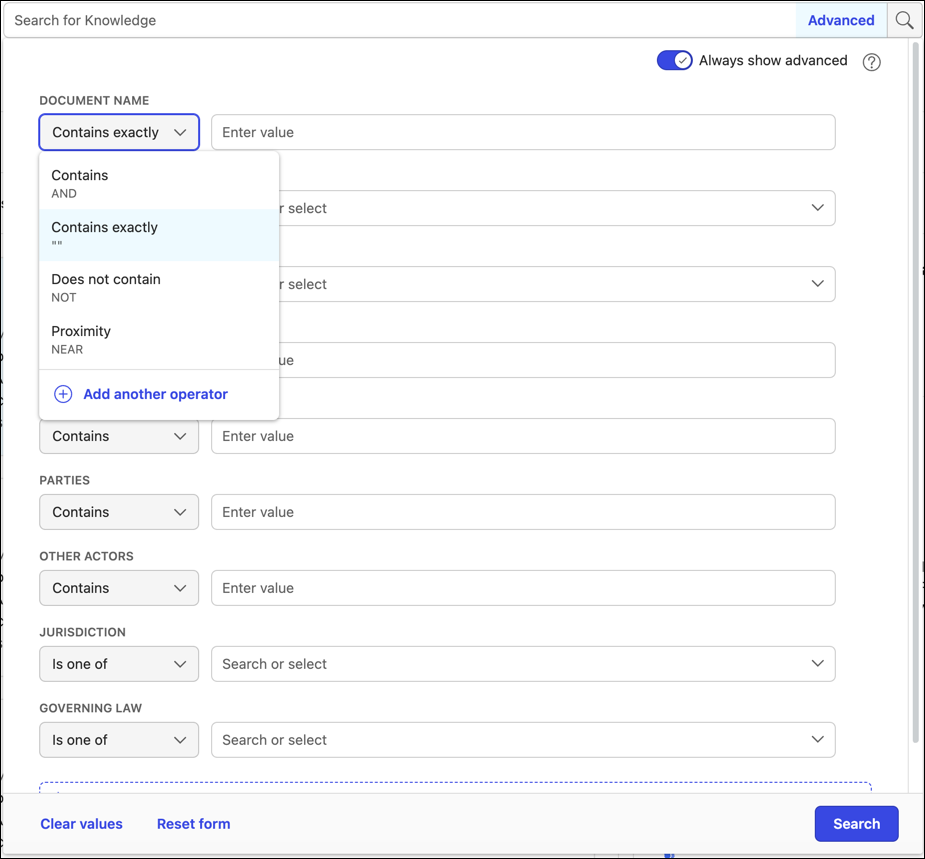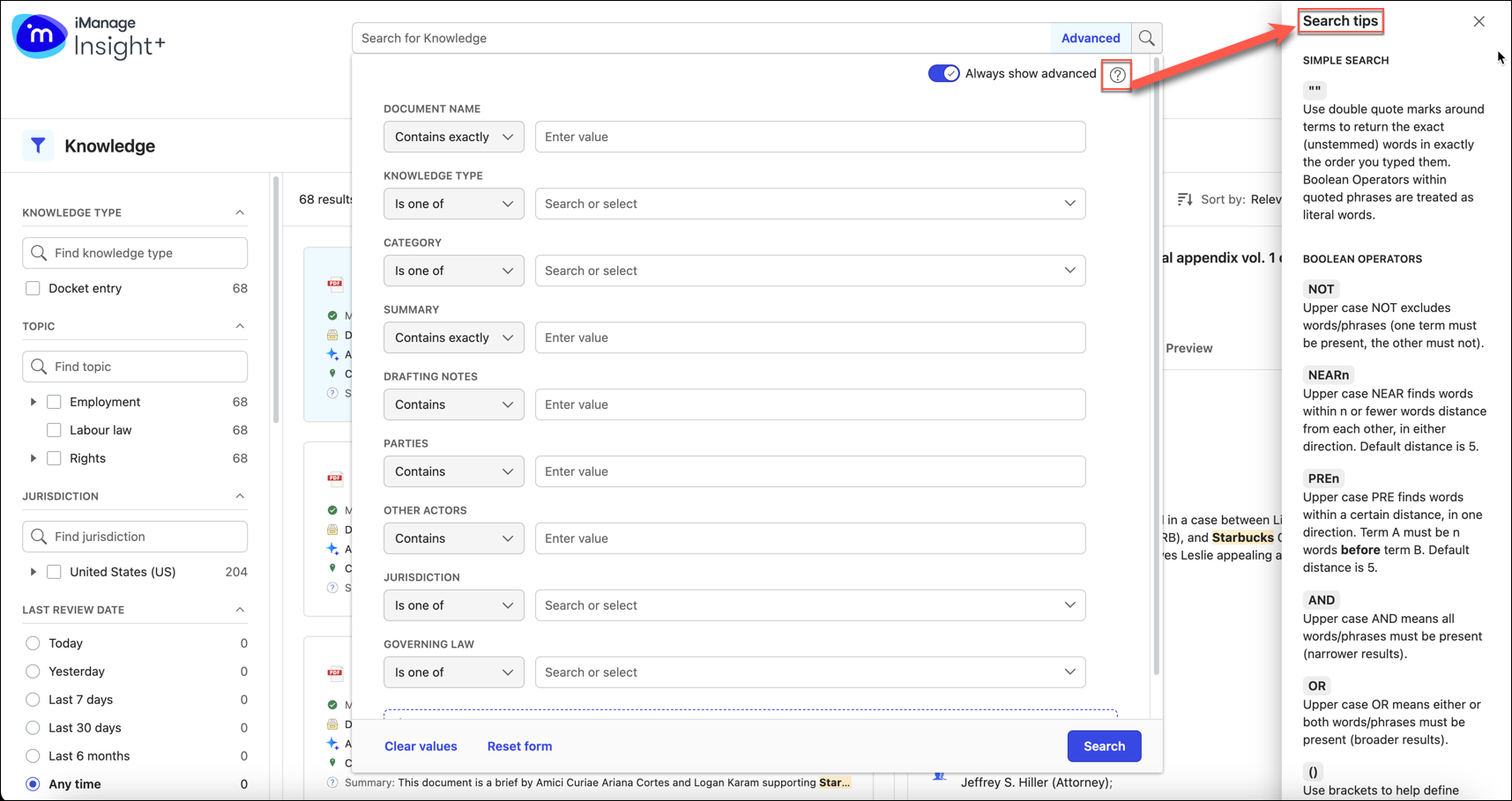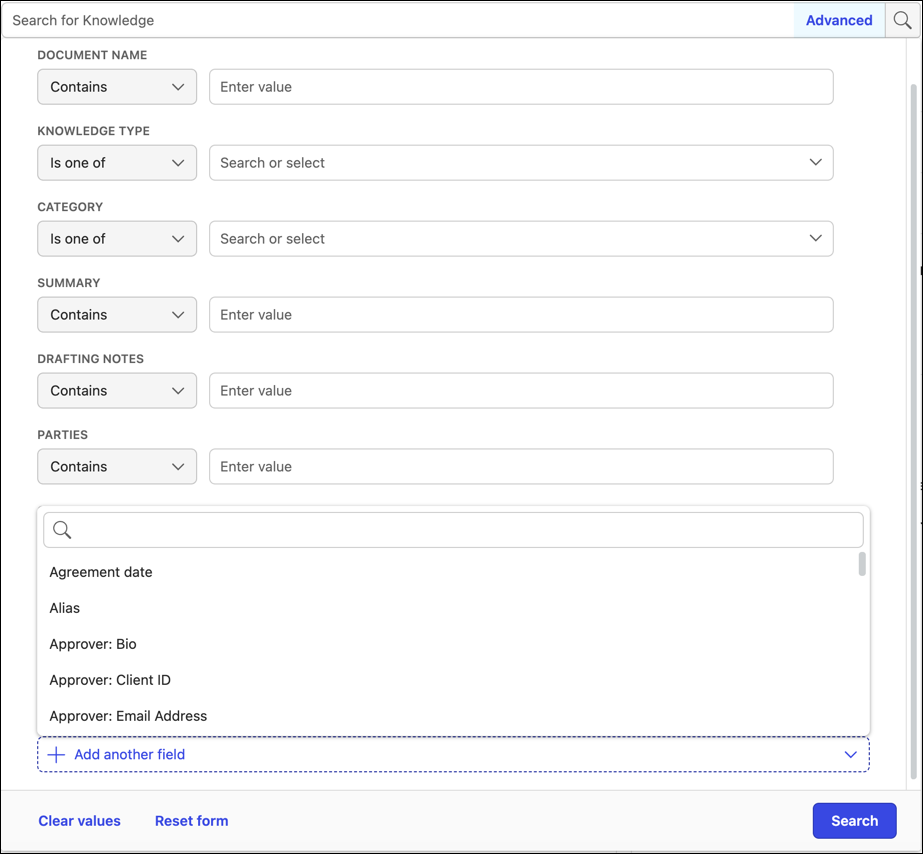In addition to searching using the simple search functionality, you can also use custom search fields to make more targeted and specific searches in iManage Insight+. Your administrator defines and configures these search fields in the iManage Insight+ administration interface.
You can set Advanced search as your default search option by sliding the Always show advanced toggle to the right. When enabled, the Advanced search button in the Simple search box is highlighted, and selecting the Simple search box will automatically open the Advanced search form.
The Always show advanced toggle is off by default. But, once selected, the setting applies automatically to all search experiences and each time you sign into Insight+. You can switch back to Simple search anytime by sliding the Always show advanced toggle to the left.
Advanced search fields or parameters can be configured differently for each tab available in the search interface.
Depending on the type of field, you'll see different options to define your search. For Text type fields (for example, Doc Name, Text, Comments), you have the following options to select from:
Contains: Items containing your term or stemmed variations of the term in this field, in any order, are returned. You may use quoted phrases (one or more), or Boolean Operators here.
If you search for the term Credit and select the Contains option, the system returns all the documents that contain the term or its variations, for example—Credited, Crediting, in the selected field.
Contains exactly: Items containing your exact (unstemmed) terms, in exactly the order as typed are returned. You don't need to type double quotes. Boolean Operators are treated as literal words when used here.
If you search for the term Credit Agreement and select the Contains Exactly option, the system returns only documents which contain exactly those two words in that order in the selected field.
Does not contain: Items containing your excluded term aren't returned. If you search for multi word terms, documents which contain any of the words in the selected field aren't returned.
If you search for Doc Name Does not contain Credit Agreement, the system will return no documents with Credit in the title and no documents with Agreement in the title.
Proximity: You can search for terms within a certain distance of each other. The second term must be within n words of the first term, that is, the terms are n or fewer words apart in either direction. If you don't specify a distance, it defaults to 5. So, all documents where the terms are given distance apart from each other are returned in the search results.
TIP: Select the search tips help icon on the search bar, to access handy tips and explanations of common search operators.Figure: Search tips dialog explaining the search operatorsAdd another operator: You can use this option to add another operator to the same field. This will add the next available operator in the drop-down list as a new search field below the existing operator.
This saves you from scrolling to the bottom of the form to select Add another field option for fields with multiple operators.
NOTE:
Add another operator is only shown for fields with multiple options.
It isn't available for Date fields, or Boolean (Yes/No) fields, such as Has Attachment.
If all available operators for a particular field have already been added, then:
Add another operator option can’t be selected.
that field will show as Already used in the Add another field drop-down list at the end of the form and can’t be selected.
Targeting specific fields in your search query can help quickly narrow results to meet your needs.
If you choose a numeric field, such as Doc Number or Version, the options are Is, Is not, and Range.
Date-based fields, such as Created or Modified, will have date range options to choose from.
Boolean fields will have the options: Any, Yes, No, Not set
Look up fields such as Type, Client, Author, Sender will have the options: Is one of, Is none of.
Advanced search allows you to run very targeted field searches while still being exploratory.
In addition to the preconfigured search fields, you have the option to include additional search field which will persist across your search sessions. Select Add another field to select from the list of custom fields available.
Similarly, you can remove any preconfigured field by selecting X in the field row.
Select Reset form to revert to the preconfigured list of advanced search fields.
To cancel all applied filter settings and close the form, click anywhere outside the form, or press the Esc key on your keyboard.
NOTE:
For some of the search results in the Everything tab, you may notice a label called “Knowledge” in front of the document name. This label indicates that the document is a curated knowledge document. Note that this label isn't displayed for results in the Knowledge tab, because they're all Knowledge documents.
A document may have multiple versions. The highest version of the document that matches the query is displayed in the search results. This may not be the latest version of the document.
For example, if a document has 4 versions, but the latest (version 4) doesn't match the query while versions 1, 2, and 3 do match—then the search results display version 3 of the document - as it's the highest matching.
In the Knowledge tab, given the above example:
If version 4 is the curated and published version of the document, no results will be returned. This is because:
Version 4 doesn't match the query, and
Versions 1, 2 and 3 match the query but aren't published Knowledge documents.
If multiple versions of a document are published as Knowledge documents, the “latest” version will be the latest published version. Previously published versions may still be returned as results if the latest one doesn’t match the query terms.




